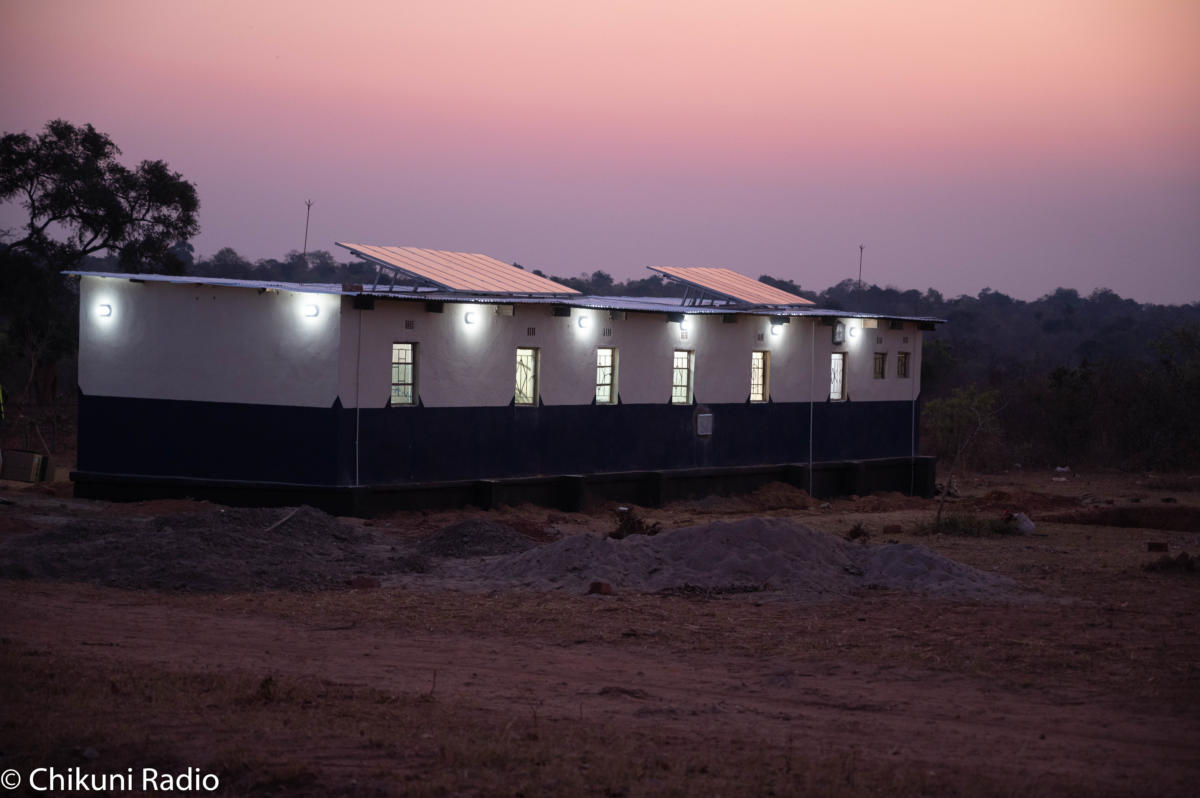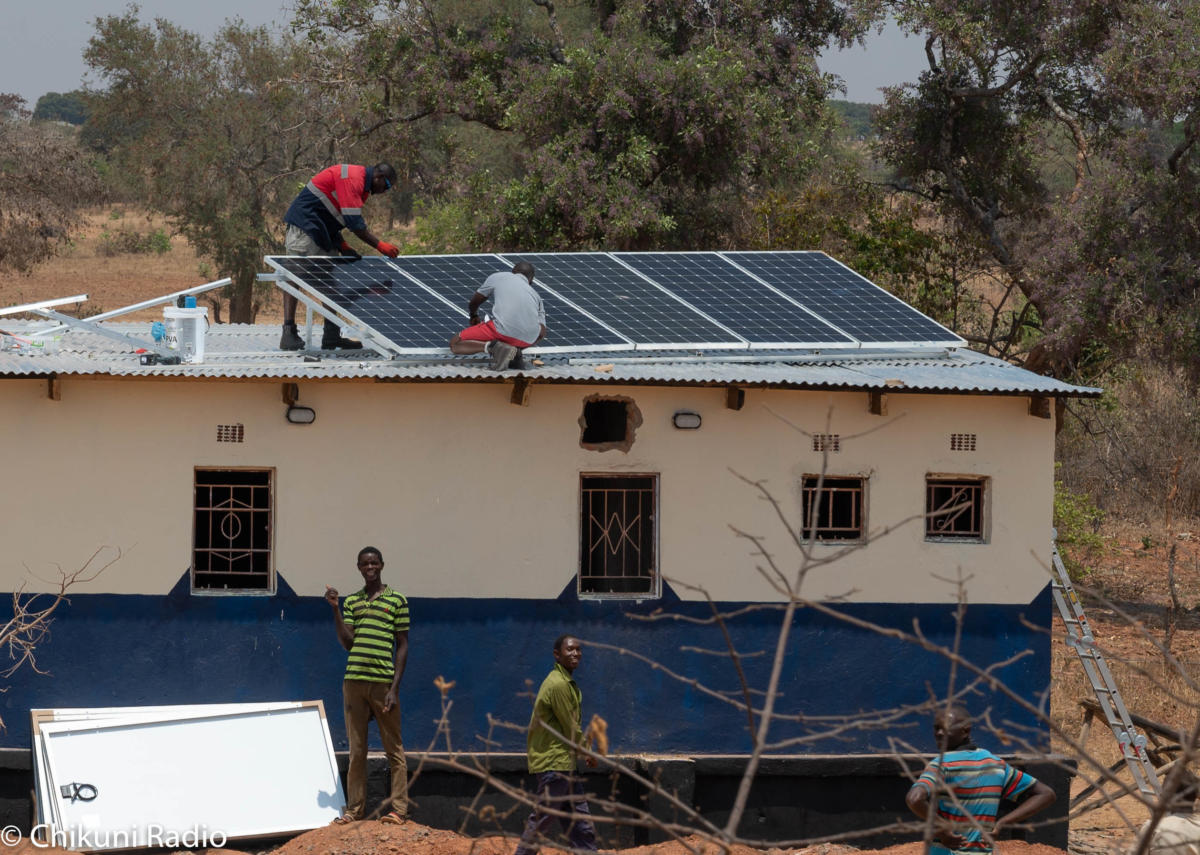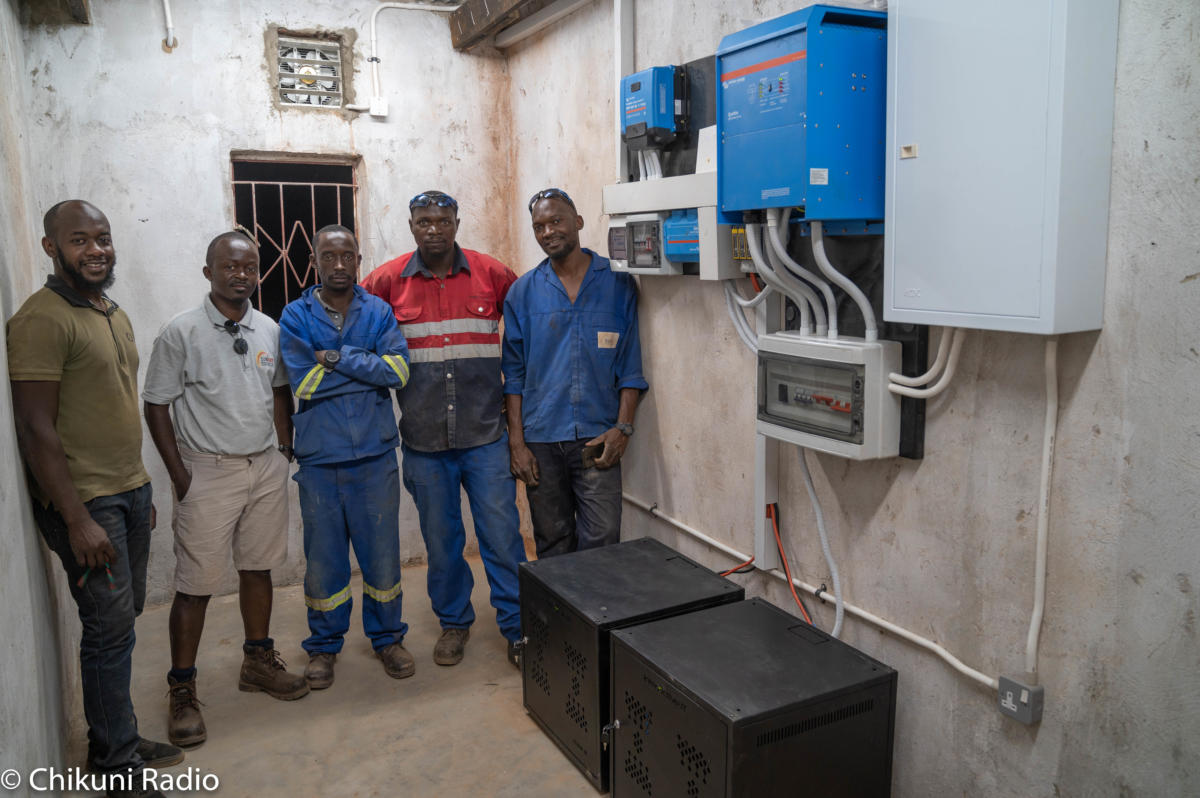KiloWatts for Humanity’s collective vision is to bring first-time access to electrification to places that most need it, focusing on renewable energy solutions in Zambia that provide economic and social benefits.
Kilowatts for Humanity (KWH) founders, board members, and volunteers fell in love with the south-central African country of Zambia in different ways — from Peace Corps to academic work to personal connections. Regardless of how they became involved, the people behind this nonprofit organization dedicate themselves to bringing economic and social benefits to remote Zambian villages — as well as outlying communities in other developing countries — via rural electrification projects.

Solar kiosk lit up at dusk. (c) Chikuni Radio. Courtesy Kilowatts for Humanity.
Most of these projects consist of solar kiosks, which are small buildings ready for specific business opportunities, as well as battery and phone charging stations to serve the community. The organization uses HOMER Pro to model its projects. HOMER Energy by UL is currently a KWH sponsor and provides the organization with a single-user license to support its projects.
Recently, Microgrid News (MGN) sat down with two dedicated KWH volunteers to learn more.
Mike Buffo has been a KWH board member for the past three years after serving in the Peace Corps in Zambia. Kirk MacLearnsberry, an electrical engineer, has been a KWH volunteer since 2015 when the then six-year-old organization was incorporated as a nonprofit. In talking with MGN, the two men shared the organization’s history, solar kiosk projects, their use of HOMER software and future plans.
When asked about the organization’s history, Buffo explained that KWH was started in 2009 by colleagues Henry Louie, Jenna Isakson and Steve Szablya at Seattle University. Louie had returned from a Fulbright Fellowship in Zambia, and Isakeson and Szablya had connections to Zambia and Kenya. Their collective vision was to bring first-time access to electrification to places that most need it, with a focus on renewable energy solutions that, in their words, “change lives in a community.”
First solar and wind kiosk, Muhuru Bay, Kenya
“Our first kiosk was in Kenya, where we installed and commissioned the Muhuru Bay microgrid in August of 2014,” MacLearnsberry said. “Unlike subsequent projects, this installation included both solar and wind to power an energy kiosk and nearby house. We provide the base resources but rely on problem-solving by the community to create income-generating projects in rural, remote areas.”
“The people we work with in the communities we serve are highly motivated to come up with creative ways to create income from these installations,” Buffo said. In Muhuru Bay, the microgrid produced energy to make ice for the fishing community and served as a charging station and convenience store. The system created more than 6 megawatt (MW) hours of energy in its first three years. However, when the Kenyan power company expanded service to the area, the grid was more affordable than the microgrid, so the team decommissioned the installation.

Kanchomba kiosk construction. (c) Chikuni Radio. Courtesy Kilowatts for Humanity.
UL’s HOMER® Pro relied on to size microgrids for solar kiosk projects
For this and subsequent projects, the organization used HOMER software to size the microgrid appropriately for the community’s exact needs. After Muhuru Bay, successive projects became a bit more uniform: all were in Zambia, they only used solar power, and energy kiosks continued to provide both charging and business opportunities. Again, however, each project had its own set of circumstances and specifics, and HOMER was used to size each microgrid to match the site’s requirements.
“Most of the projects are fairly similar,” MacLearnsberry said, explaining that each has a solar kiosk — one building that is usually a shop or service such as a barbershop, with similar types of electric loads like freezers and battery and cellphone charging.
“The load profiles are similar but need to be modeled because of differences in size. For example, last year’s project was twice the size we’d done previously and added a water pump,” he said.
This year’s kiosk project includes a welding shop with tools.
“We develop load profiles in-house and use HOMER to optimize the number of panels and batteries,” Buffo said. Once system size is determined, KWH uses that information to create a request for proposal (RFP) for each project.

In the Kanchomba control room. (c) Chikuni Radio. Courtesy Kilowatts for Humanity.
Community initiatives key to solar kiosk project success
MacLearnsberry praised the level of initiative by the community members involved with the KWH Zambian installations. On his first trip to Zambia, he said, he left his laptop charging at the solar kiosk while running an errand. When he returned, he found a 14-year-old boy in the shop had used his laptop to create a resume, which the young man then used to apply for a position working at the kiosk shop.
At another site, the income earned by the manager of the kiosk store enabled her to build a house for her family.
Bringing electricity to these communities clearly makes an impact. When Buffo performed a project assessment on one Zambian planning site, he was met by a group of 30 villagers arranged on circular benches under a tree. The villagers showed Buffo and the team the work they had done to create agricultural storage.
“They had enthusiasm around the business idea of processing food and figured out how they could generate an income with the help of electricity,” he explained.
To learn more about KWH and to get involved, visit the organization’s website and subscribe to its newsletter.

UL Solutions’ HOMER® Pro is the leading pre-feasibility design software for modeling microgrids, with more than 250,000 users in more than 190 countries. It provides engineering and financial analyses of remote, off-grid and grid-tied complex distributed energy systems, helping reduce financial risk for owners and developers. Learn more about HOMER Pro and download a complimentary trial.

I am National Renewable Energy Coordinator in Aga khan Foundation
Hello Sayed, thank you for stopping by and reading our story on KiloWatts for Humanity.
Great initiative. It would be nice to have the KWH configuration and capital expenses used in Kenia and Zambia as a reference to use in other remote villages at undevelopmemt countries worldwide.
Hi Javier, Thank you for reading. We contacted Kirk MacLearnsberry with your question. Here is his reply, “Regarding capital costs, prices for solar modules have continued to decline in recent years, so looking at our latest installations in Zambia (in the 3-5 kW range), we have seen a capital cost of around $2.2/W dc for the solar and about $0.22/Wh for the battery system (installed).” He also said that if you would like to see the design drawings, you can contact him at .
well done ya we Ethiopians too running to secure kwh from different renewables .
Let us elevate our mother Africa
Thank you for your comment, Mintesnot. Congratulations on the work you are doing in Ethiopia to provide renewable electricity.